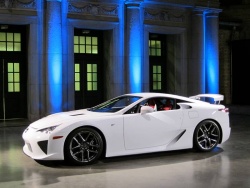 Lexus LF-A. Click image to enlarge |
|
Related articles on CanadianDriver
Manufacturer’s web site
|
Article and photos by Jil McIntosh
Photo Gallery:
Lexus LF-A
Toronto, Ontario – My Lexus LFA is sky blue, with gold-painted calipers and bright wheels. The seats are tan leather, the carpet and the headliner are camel yellow, and the steering wheel matches it all. Alas, it’s not one of the ten that have already been allotted to select buyers in Canada, but for a little while I had some of the feeling of ordering one of my own, at a Lexus event intended to show some “behind the scenes” into this new supercar.
There will only be 500 LFAs built for sale worldwide – about 150 will go to our neighbours south of us – all hand-assembled in Japan at the rate of no more than twenty a month. When the last one rolls out the door, it will mark the end of the model. Still, it’s not just about those five hundred cars by themselves, but about the technology, styling cues and performance that will eventually work their way into other Lexus vehicles. In a way, the LFA is almost a concept car that you can buy, a rolling development instrument with its various proprietary features and technologies.
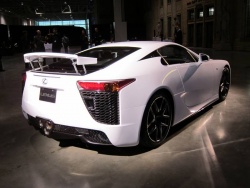 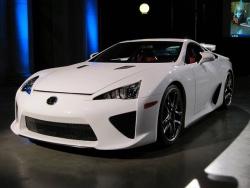 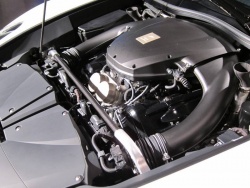 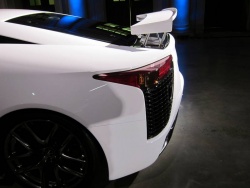 Lexus LF-A. Bottom photo: The rear wing deploys at 80 km/h. Click image to enlarge |
All of this comes with a hefty price tag, of course, and the LFA is $405,500 in Canadian funds. You can bump that up with some of the specialty colours, or for a real treat, add another $75,000 for the Nurburgring Edition, which add another ten horsepower, faster shift speeds, different suspension tuning and unique styling cues, wheels and tires. There are fifty of those, with one coming to Canada.
The LFA name refers to Lexus, to Fuji where it was designed and engineered, and for Apex, as in the pinnacle of achievement, the company said. It uses a front-mounted, LFA-unique 4.8-litre V10 engine, engineered in conjunction with Yamaha Motor Works, producing 552 horsepower and 354 lb-ft of torque. Yamaha also assembles the engine, each one built by a single worker who then signs it. The engine is mated to a rear-mounted six-speed sequential single-clutch gearbox, activated by paddle shifters on the steering wheel. The shift times can be driver-tuned from 0.2 to one second, and the whole system can be dialed into auto, normal, wet or sport. When in that last one, the redline moves up on the LCD tachometer. The LFA can accelerate from zero to 100 km/h in 3.7 seconds to a top speed of 325 km/h. I had to take the company’s word on that, since the car on display was a prototype on loan from Japan for the auto show circuit, and the possibility of a journalist slinking too fast around a corner definitely wasn’t in the cards. I did get to hear it run, though, and there’s certainly a healthy, high-revving roar from the three exhaust tips peeking from under the rear fascia. Although you wouldn’t expect it to be much of a concern at this level, the LFA’s engine can shut off five of its cylinders when not needed, to reduce emissions while idling.
The LFA has been in development for ten years and was originally intended to be rendered entirely in aluminum. Along the way, it was decided that even that lightweight material was too heavy, and so 65 per cent of the chassis is now carbon fibre, for a weight savings of 136 kilograms over aluminum. Everything makes a difference, no matter how small, and so even the hood prop rod is made from the costly cloth, and weighs a mere eight grams. Overall, the car is a flyweight, coming in at a maximum of 1,580 kilograms.
    Top: Drivetrain settings are controlled via a dial beside the instrument cluster;Two chimneys vent exhaust heat or draw in cool air. Click image to enlarge |
Carbon fibre by itself isn’t breaking news, but there’s a twist here. The company uses a proprietary method for spinning the fibres to form components, a nod to the original Toyoda Loom Works, the company formed in 1926 that eventually produced the Toyota Motor Company.
Numerous interesting features are found throughout the car. Getting the sound right was important, and so a “surge tank” was developed in conjunction with Yamaha – the musical division this time – that’s toned for frequency. The sound runs through three channels that funnel it to the driver for a surround sound experience of engine rumble. Two heat risers, which Lexus calls “chimneys,” stand on either side of the engine; these draw heat from the exhaust manifold and send it out through the hood vents. Brakes are carbon ceramic, of course, and the stock Bridgestone Potenza tires, developed specifically for the LFA, have an asymmetrical pattern but are not unidirectional, so they can be rotated. The radiators and electric fans are at the rear, fed their air through vents molded into the body behind the side windows, which helps to achieve a weight distribution of 48/52 front to rear. And the seatbelts have airbags in them – a first for an automaker, Lexus said, although Ford may actually have the jump on them with the similarly-equipped belts offered in the rear seats of the new Explorer.
With so few LFAs available, there was far more to it than just walking up to a salesman and haggling over the details. Dealers identified potential buyers, who were then met by personnel from Lexus’ head office. Names “went into a hat,” according to the company – the exact number wasn’t revealed – and ten people were selected. Those who missed out were given the opportunity to go on a waiting list, should any of the ten change their minds. To prevent the vehicles being flipped for profit, they’re leased for the first two years, with a small buyback at the end of it to purchase the car outright.
  Top: Two chimneys vent exhaust heat or draw in cool air; The salesman’s case, with paint colour choices, interior options and wheel styles, is a $20,000 unit. Click image to enlarge |
I was walked through the stages the real buyers experienced, with an opportunity to select colours at a special online site. There is much to be decided: Alcantara or leather seat fabric, colours for the seat fronts and backs, steering wheel, door grips and instrument panel, the carpet and headliner shades, the stitching and floor mats, and the interior trim. In addition to the car colour – ten standard and twenty optional shades, including Passionate Pink – I also had to pick from six brake caliper colours, three wheel designs, and whether I wanted my rear spoiler with little “winglets” or not. A computer screen isn’t always the most accurate for pigments, and so I then was taken to the “suitcase,” a salesman’s briefcase that contains miniature wheels and brake calipers, samples of fabric and stitching materials, and colour chips. The case itself costs $20,000 to produce, and I can only imagine what one might bring on eBay in the years to come.
When I was done configuring my car, the final pictures were printed out and handed over – the closest I’ll get to having one to take home. The ten cars will be going to buyers in Montreal, Ottawa, Toronto, Windsor, Calgary and Vancouver and will be built sometime over the next two years. I’m guessing the new owners will figure it’s worth the wait.







 Follow CanadianDriver on Twitter
Follow CanadianDriver on Twitter



